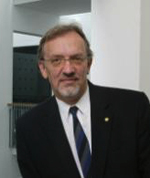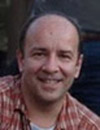Go to
Jan-Anders Månson
 Professor
Professor
Laboratory of Polymer and Composite Technology, Director
Swiss Federal Institute of Technology, Lausanne, Switzerland
Tuesday, 14 December 2010 (10h40-11h20), EPFL Polydôme
Energy and Transportation: A time when all options are explored
The presentation will highlight different research and development routes currently under exploration in the road transportation field. Today, it’s not just the OEM’s who try to find new alternatives but we also see very dynamic innovation efforts among other established companies and start-ups. This has created a very stimulating research activity within an industrial domain which otherwise is rather traditional. The new alternative will shake up traditional ideas of how cars are built and integrated to a functional infrastructure of energy supply. Within this context, there will be new demands on how energy is generated and distributed into a functional infrastructure, which can serve the consumers.
About the speakers:
Jan-Anders E. Månson, born 1952 in Örkelljunga, Sweden. He obtained his PhD-degree in Mechanical Engineering from Chalmers University of Technology, Gothenburg, Sweden, in 1981. After 5 years as head of the R&D department of Konstruktions-Bakelit AB, Sweden, he was appointed Professor at the University of Washington (Department of Chemical Engineering), Seattle in 1987, and at the Royal Institute of Technology (Department of Polymer Technology), Stockholm in 1989.
In 1990, Jan-Anders Månson joined the Ecole Polytechnique Fédérale de Lausanne (EPFL) as Professor and Director of the Polymer and Composite Laboratory (LTC) at the Institute of Materials. His research is focused on novel cost-effective materials and manufacturing principals as well as unique additional functionality, beyond classical performance of composite materials. Emphasis is placed on scaling and implementation strategies for an industrial context. The research partners are primarily in the automotive, aerospace, medical and sport industry. Prof. Månson has 500 scientific publications and teaches courses in the above mentioned fields and is acting on the editorial board of several scientific journals. During the period 2004-2008, Professor Månson was Vice-president at the Ecole Polytechnique Fédérale de Lausanne, responsible for Innovation and Technology Transfer, and since 2008 president of the International Sport Academy – AISTS, an organisation linking Academic institutions in collaboration with the Internaltional Olympic Committee (IOC).
Current engagements:
Academic: - International Academy of Sports Science and Technology, AISTS, (President)
- Lund University (Advisory Board)
- Korean Institute of Science and Technology, KIST, (Advisory Board)
Governmental: - Vinnova - Swedish Governmental Agency for Innovation (Board Member)
- Swiss Federal Lab. for Materials Sci. and Tech., EMPA, (Advisory Board)
- Antidoping Switzerland Foundation (Board Member)
 Yves Leterrier joined EPFL in 1993, and is currently a senior scientist and lecturer in the Laboratory of Composite and Polymer Technology. In 2006 he was nominated as faculty member of the Materials Science Institute of the EPFL.
Yves Leterrier joined EPFL in 1993, and is currently a senior scientist and lecturer in the Laboratory of Composite and Polymer Technology. In 2006 he was nominated as faculty member of the Materials Science Institute of the EPFL.
He holds a PhD in Materials Science and Engineering from the Institut National Polytechnique de Lorraine, France and was a research associate of the Polymers Division at the National Institute of Standards and Technology (NIST, USA) prior to joining the EPFL.
His research work is devoted to multifunctional polymer-based composite materials including nanosized coatings on polymer substrates, for which he won the 2001 Wasserman prize. Emphasis is put on encapsulation materials with improved mechanical integrity, for applications such as food and pharmaceutical packaging, flexible electronics, optical and photovoltaic devices. Ongoing research also focuses on nanocomposites based on UV curable hyperbranched polymers. These materials combine unique properties (short process time, transparency, dimensional accuracy) relevant for microdevice technologies including lab-on-a-chip and optical sensors.
A significant contribution of his work is in the development of new experimental methods:
- electro-fragmentation in-situ in microscopes to probe damage in nanometric layers under controlled thermo-mechanical loading
- UV-hyphenated tools (rheology, interferometry) for real-time structure-property analysis in photosetting polymers
Secondary navigation
- EPFL Workshop on Logic Synthesis and Emerging Technologies
- Luca Amaru
- Luca Benini
- Giovanni De Micheli
- Srini Devadas
- Antun Domic
- Rolf Drechsler
- Pierre-Emmanuel Gaillardon
- Jie-Hong Roland Jiang
- Akash Kumar
- Shahar Kvatinsky
- Yusuf Leblebici
- Shin-ichi Minato
- Alan Mishchenko
- Vijaykrishnan Narayanan
- Ian O'Connor
- Andre Inacio Reis
- Martin Roetteler
- Julien Ryckaert
- Mathias Soeken
- Christof Teuscher
- Zhiru Zhang
- Symposium on Emerging Trends in Computing
- Layout synthesis: A golden DA topic
- EPFL Workshop on Logic Synthesis & Verification
- Luca Amaru
- Luca Benini
- Robert Brayton
- Maciej Ciesielski
- Valentina Ciriani
- Jovanka Ciric-Vujkovic
- Jason Cong
- Jordi Cortadella
- Giovanni De Micheli
- Antun Domic
- Rolf Drechsler
- Henri Fraisse
- Paolo Ienne
- Viktor Kuncak
- Enrico Macii
- Igor Markov
- Steven M. Nowick
- Tsutomu Sasao
- Alena Simalatsar
- Leon Stok
- Dirk Stroobandt
- Tiziano Villa
- Symposium on Emerging Trends in Electronics
- Raul Camposano
- Anantha Chandrakasan
- Jo De Boeck
- Gerhard Fettweis
- Steve Furber
- Philippe Magarshack
- Takayasu Sakurai
- Alberto Sangiovanni-Vincentelli
- Ken Shepard
- VENUE
- Panel on Circuits in Emerging Nanotechnologies
- Panel on Emerging Methods of Computing
- Panel on The Role of Universities in the Emerging ICT World
- Panel on Design Challenges Ahead
- Panel on Alternative Use of Silicon
- Nano-Bio Technologies for Lab-on-Chip
- Functionality-Enhanced Devices Workshop
- More Moore: Designing Ultra-Complex System-on-Chips
- Design Technologies for a New Era
- Nanotechnology for Health
- Secure Systems Design
- Surface Treatments and Biochip Sensors
- Security/Privacy of IMDs
- Nanosystem Design and Variability
- Past Events Archive
Downloads
Smart Energy Day Presentation Slides
Massoud Pedram (2.2.MB pdf)
Mario Paolone ( 7.34 MB pdf) in place of Carlo A. Nucci
David Atienza (1.4 MB pdf)
Dejan Kostic (708 KB pdf)
Patrick Ruch (3.4 MB pdf) in place of Bruno Michel
Links
Watch Smart Energy Day Presentations:

